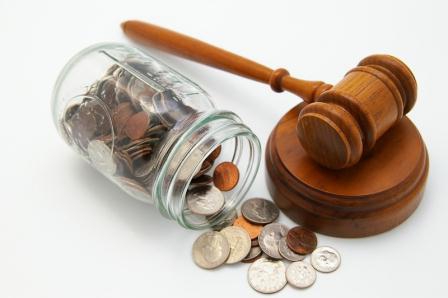This article will focus on fictitious bankruptcy, and will also describe the legal nature that defines intentional bankruptcy. In addition, a comparative description of the two types of bankruptcy will be given, as well as the liability that is imposed for the commission of this crime.
Definition of a concept

Bankruptcy - the inability of the debtor to fully satisfy the claims of creditors regarding monetary obligations.
Articles of the Criminal Code define common signs of bankruptcy, which include:
- The debtor has a liability in cash.
- Inability of a legal or natural person to satisfy incoming creditors' claims regarding monetary obligations.
- The presence of debts from an individual is not less than 10 thousand rubles, and from a legal entity - not less than 100 thousand.
- Official recognition by the arbitrator of the insolvency of the debtor.
Illegal actions in bankruptcy proceedings

Fictitious bankruptcy and intentional characterized by the commission of certain unlawful actions, which include:
- Concealment of property, as well as rights to it, information that includes data on the location, size, transfer to another possession or alienation.
- Failure to fulfill obligations regarding the transfer of the application to the court declaring the debtor bankrupt.
- Failure to comply with established rules that apply during the period of observation, bankruptcy proceedings, external management, conclusion or execution of a settlement agreement.
- Document fraud accounting or other income-related data.
Intentional bankruptcy
This type of bankruptcy is expressed in the deliberate creation or increase of insolvency of the organization, which is carried out through the actions of the owner or manager in order to satisfy their personal interests. Also, a crime can be expressed in the form of causing serious damage to an enterprise by concluding unprofitable transactions, assuming the debts of third parties, and incompetent business management, which lead to the inability to satisfy the legitimate requirements of the creditor.

The direct object of bankruptcy is the economic activity of the enterprise, which is under the protection of current legislation. An additional object is an established procedure that determines the conduct of bankruptcy proceedings.
The role of the creditor in this case belongs to legal entities and individuals who are entitled to make independent claims on enterprises and organizations.
Intentional bankruptcy is artificially provoked. The objective side includes three main elements:
- An act expressed as inaction or action.
- A causal relationship between a consequence and an act.
- The consequences are in the form of major damage.
Bankruptcy is committed in the process of taking action. In some cases, it can be triggered by inaction. Then the objective side is the improper performance by the head of his direct duties.
The subjective side is characterized by a direct form of guilt. In this case, the official sets the goal of bringing the company to insolvency and for a long time goes to the goal.
This crime is also committed through indirect intent. In this case, the dangerous consequences will be an intermediate phenomenon or a by-product of illegal actions.
Signs of Intentional Bankruptcy

Identification of signs of bankruptcy can be carried out in the process of inventory, target financial condition of the debtor or audit check.
In the process of conducting inspections, special attention should be paid to the signs:
- the presence of unpaid receivables;
- concealment of property or obligations of the debtor;
- the availability of financial investments made during the period when the debtor suspended current payments.
The insolvency of the enterprise is achieved by alienation of a certain part of the property. The arbitration manager is required to analyze the firm’s transactions over the past two years that preceded the start of bankruptcy proceedings. Particular attention should be paid to atypical agreements (transactions with non-market conditions). This type of transaction, as a rule, entails a decrease in the solvency of the organization.
When an examination of intentional bankruptcy is carried out, the following shall be subject to mandatory investigation:
- constituent documentation of the debtor;
- list of debtors and creditors;
- financial statements;
- certificates of arrears;
- business valuation reports;
- court materials;
- tax documentation;
- audit reports;
- reports of audit commissions.
In all of these documents arbitration manager must identify the reasons due to which the financial condition of the company has worsened, and also check whether it is possible to satisfy creditor claims.
As a result of the audit, a conclusion is drawn up on the basis of which a further investigation of the case is conducted.
A responsibility
Legislation criminalizes intentional bankruptcy. The Criminal Code of the Russian Federation presupposes a fine in the amount of 100 to 300 thousand or a seizure of an amount equal to the income of the convicted person for the last two years of labor. A preventive measure is also possible in the form of imprisonment of up to 6 years in conjunction with a fine of up to 80 thousand rubles (Article 196).
As you know, the very fact of intentional bankruptcy does not entail criminal liability. This act acquires the signs of a criminal only if there are two fundamental signs: intent and nature of the consequences.
Although bankruptcy, by its nature, always entails negative consequences, it is necessary to inflict especially large damage, which exceeds 250 thousand rubles, for the onset of criminal liability.
Definition of fictitious bankruptcy

Fictitious bankruptcy is a deliberately false recognition by the head of an enterprise of the insolvency of a controlled legal entity, expressed by applying to arbitration in order to declare the organization bankrupt, as well as the inability to satisfy the claims of creditors.
In this case, the crime will consist in causing material damage to creditors by misleading them about the actual financial situation of the debtor enterprise.
Signs of Fictitious Bankruptcy

Fictitious bankruptcy is determined by a number of signs, the main of which is the presence of the debtor the ability to satisfy in full or in part the claims of the creditor that were established at the time of appeal to arbitration. If a bankruptcy petition was submitted by one of the creditors, then there would be no corpus delicti.
Also a sign of fictitious bankruptcy can be considered the funds of the debtor, which are stored in various bank accounts.
The presence of signs of bankruptcy is established due to the analysis of the degree of solvency of current obligations, as well as the security of the debtor's obligations with necessary current assets.
The degree of solvency is determined by the ratio of the debtor's liabilities to the established average monthly income for the analyzed period.
Responsibility for fictitious bankruptcy

For this type of bankruptcy, the state provided for liability, which is fixed by certain articles of the Criminal Code. So, Art. 197 of the Criminal Code provides for liability for the false recognition by the head of the enterprise or organization of his insolvency in order to mislead creditors for further non-payment of accumulated debts. The preventive measure for this type of crime provides for a fine of 500 to 800 minimum wages, or in the amount of income received for a period of 5 to 8 months of labor. The law also provides for imprisonment of up to 6 years, along with a fine, which is equal to 100 minimum wages.
Comparative analysis of two types of bankruptcy
In order to better deal with the two types of criminal acts, you need to understand what distinguishing features they possess. Schematically, such information can be presented in the table.
Comparative characteristics of types of bankruptcy
| Sign for comparison | Fictitious | Intentional |
| The concept | Obviously false announcement by the head of the organization of his insolvency in the matter of repayment of accounts payable. | Intentional bankruptcy is the performance of certain actions on the part of a legal or natural person that have led to the inability to pay off payables. |
| purpose | To mislead creditors for the purpose of installment plan or deferred payment, and in some cases even with the intent of non-payment of debt. | Misappropriation of assets of an enterprise. |
| Criminal liability | A fine of 100 thousand, the withdrawal of funds equal to the amount of income in the period from 1 to 2 years of labor of the offender. Imprisonment of up to 6 years in conjunction with a fine of up to 800 thousand rubles. | A fine of 200 thousand, payment of the amount of money, which is equal to the total earnings from 1 to 3 years of the debtor's legal labor. Imprisonment of up to 6 years in conjunction with a fine of up to 200 thousand rubles. |
| Administrative responsibility | A fine of 50 to 100 minimum wages or suspension for a period of 3 to 6 years. | A fine of 50 to 100 minimum wages or disqualification from 1 to 3 years. |
Conclusion
In conclusion, it should be noted that the signs of fictitious and intentional bankruptcy have cardinal differences among themselves. Based on the foregoing, it should be noted that bankruptcy is fictitious, in which the head of an institution or enterprise goes to arbitration for no reason to declare its organization insolvent. An act is committed with a view to the subsequent non-payment of debt to creditors.
Bankruptcy is considered deliberate, in which the company or organization is really not able to pay off accumulated payables due to deliberate or negligent conduct of business by an authorized official.








